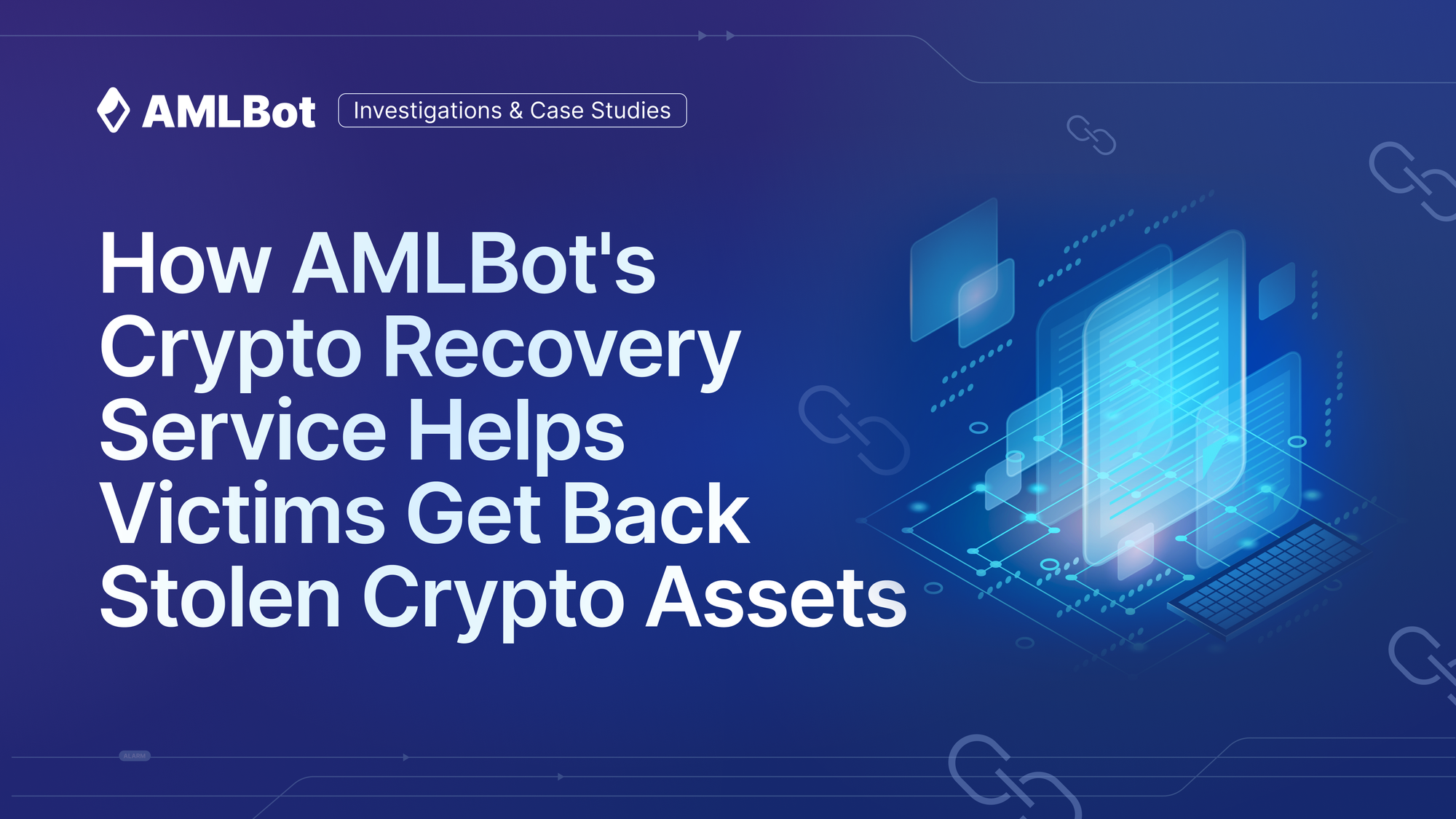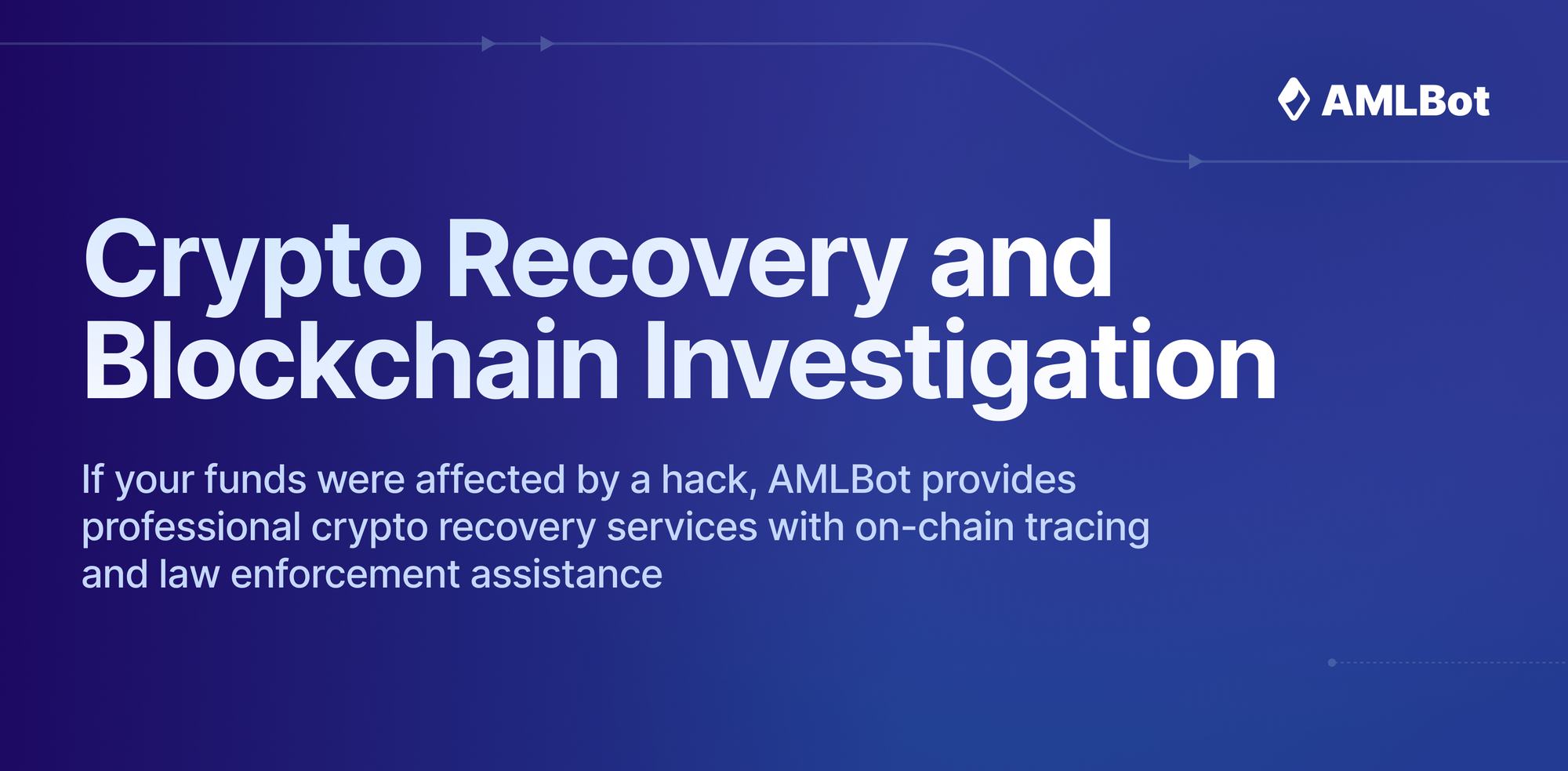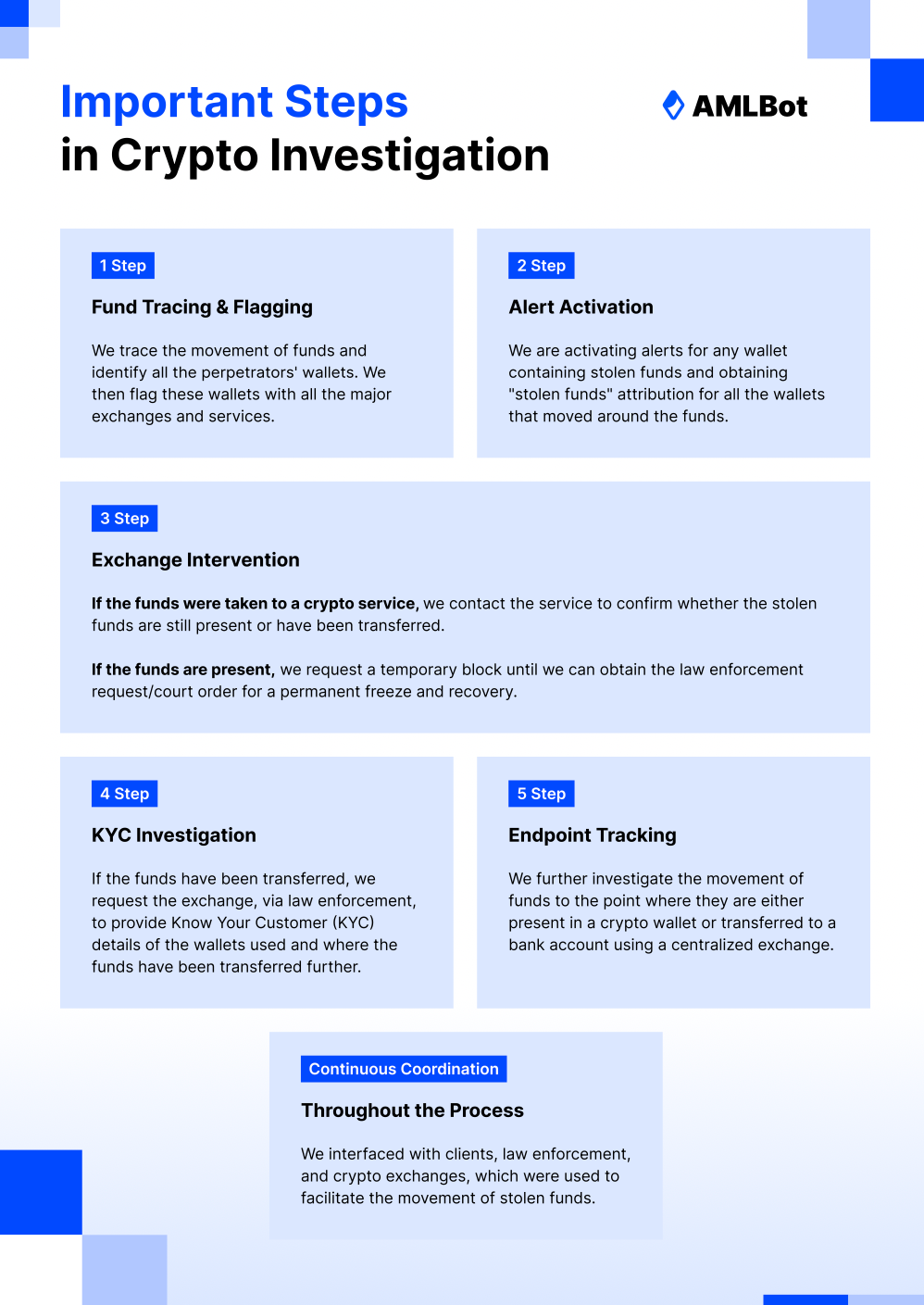How AMLBot's Crypto Recovery Service Helps Victims Get Back Stolen Crypto Assets

The cryptocurrency adoption has brought opportunities alongside risks. As digital asset markets mature, criminals have developed complex attack vectors to steal funds from unsuspecting victims. In this environment, crypto recovery service providers like AMLBot have emerged as critical allies for victims seeking to recover their stolen assets through professional blockchain investigation and asset tracing capabilities.
The need for specialized recovery services is more urgent than ever. According to the official FBI Internet Crime Complaint Center (IC3) 2024 Annual Report, Americans lost approximately $9.3 billion to cryptocurrency fraud in 2024 , marking a 66% increase compared to 2023. Globally, cryptocurrency theft reached record levels in the first half of 2025, with over $2.17 billion stolen from crypto services alone. These figures underscore the challenges victims face when attempting to recover stolen cryptocurrency independently.
Understanding what constitutes a crypto recovery service is essential. These specialized firms combine blockchain forensics, legal expertise, and law enforcement coordination to trace stolen funds across complex transaction networks. Unlike traditional financial systems where transactions can be reversed, cryptocurrency's immutable nature requires sophisticated technical approaches to track, identify, and potentially freeze stolen assets before they disappear permanently into laundering networks.
Below, we examine what crypto recovery service providers do and how AMLBot specifically helps victims navigate the process of asset recovery in the cryptocurrency ecosystem.
If you were affected by a crypto-related incident, please complete the form above to get immediate help.

How AMLBot's Crypto Recovery Service Works
AMLBot's Crypto Recovery Service follows a systematic six-step process designed to maximize the chances of successful asset recovery. The process begins immediately upon receiving a victim's report, recognizing that time is critical in cryptocurrency investigations where funds can be moved across multiple blockchains within minutes.
Step 1: Fund Tracing & Flagging. AMLBot's Investigation Team traces the movement of stolen funds across blockchain networks, identifying all wallets controlled by the perpetrators. These addresses are immediately flagged across major cryptocurrency exchanges and service providers, creating alerts that can prevent further movement of stolen assets.
Step 2: Alert Activation. The team activates monitoring alerts for any wallet containing the stolen funds, ensuring continuous surveillance of criminal addresses. This provides "stolen funds" attribution across all identified wallets involved in moving the assets, creating a comprehensive map of the criminal network.
Step 3: Exchange Intervention. When stolen funds reach cryptocurrency exchanges, AMLBot contacts the platform to confirm whether the assets remain present or have been transferred elsewhere. If funds are still available, the team requests temporary freezing measures while working to obtain law enforcement requests or court orders for permanent asset recovery.
Step 4: KYC Investigation. If funds have been transferred from exchanges, AMLBot works with law enforcement to request Know Your Customer (KYC) details from platforms. This critical step helps identify the real-world identities behind criminal wallets and tracks where funds have been moved next in the laundering chain.
Step 5: Endpoint Tracking. The investigation continues tracking fund movement until assets are either located in accessible wallets or traced to bank accounts through centralized exchanges.
Throughout the Process: Continuous Coordination. AMLBot maintains ongoing communication with clients, law enforcement agencies, and cryptocurrency exchanges throughout the investigation. This collaborative approach leverages multiple stakeholders to maximize recovery potential while ensuring proper legal procedures are followed. The effectiveness of this systematic approach is demonstrated through AMLBot's track record of successful recoveries across diverse case types, from individual wallet compromises to large-scale fraud schemes.

Real Cases Of Stolen Crypto Recovery
AMLBot's crypto recovery service has demonstrated success across various types of cryptocurrency theft and fraud cases. These real-world examples illustrate how different attack vectors can be addressed through systematic blockchain investigation and multi-stakeholder coordination.
Crypto CEO Case: Successful Asset Recovery After WiFi Attack
Here’s just one example covered by Decrypt to show what a successful recovery can actually look like in practice.
A former crypto CEO, who had recently sold his stake in a project for half a million dollars, thought he was safe when he re-settled in Asia. Over time, he grew close to a local acquaintance, someone he came to call his “best friend.” But that trust became the very weapon used against him. One night, after his phone was damaged and he had to re-enter his seed phrase, he discovered the unthinkable: $450,000 of his life savings had vanished.
At first, it looked like an unsolvable case, a so-called “proximity breach,” where someone physically close to the victim exploits that trust to steal funds. The attacker had compromised his device simply by getting him to connect to a WiFi network.
The victim contacted AMLBot, and investigators quickly traced the stolen funds moving across Ethereum and Binance Smart Chain. Even though criminals often hide behind mixers or privacy coins, this attacker hadn’t covered his tracks well enough. AMLBot coordinated with Binance and other exchanges, freezing the funds before they could be laundered further. From there, the investigation tightened the net. The team even went undercover, making contact with the scammer under a fake identity. Faced with pressure, and aware that Binance had already blocked his account, the attacker confessed. Within weeks, the majority of the stolen funds were returned, and the remainder was settled in installments. In the end, $450,000 that seemed lost forever was recovered.
While individual cases like this demonstrate effectiveness with targeted theft, the platform's capabilities extend to much larger-scale incidents involving sophisticated criminal networks and multiple victims.
Banana Gun Case
The Banana Gun Telegram trading bot exploit in September 2024 demonstrated AMLBot's capability to provide incident response and real-time asset monitoring during active cryptocurrency attacks. When the popular trading bot suffered a vulnerability that put user funds at risk, AMLBot's blockchain forensics team immediately mobilized to assist both the platform and affected users.
On September 19, 2024, the Banana Gun trading bot experienced a sophisticated attack that resulted in approximately $3 million being stolen from 11 experienced cryptocurrency traders. This exploit targeted traders known for their expertise and social presence in the crypto community. The attackers exploited a vulnerability in the Telegram Message Oracle, allowing them to manually transfer ETH from victims' wallets while users were actively interacting with the bot.
The comprehensive asset tracing conducted by AMLBot proved invaluable for both the Banana Gun Team and affected users.

By mapping the complete flow of stolen funds and identifying the attackers' wallet infrastructure, AMLBot increased the likelihood of successful asset freezing if criminals attempted to deposit funds on centralized exchanges. AMLBot also provided crucial intelligence about the attack methodology, helping to confirm that the exploit targeted the Telegram Oracle vulnerability rather than the bot's core trading infrastructure. This technical analysis supported Banana Gun's internal investigation and contributed to the patching of the security flaw.
Why Choose AMLBot For Crypto Asset Recovery
AMLBot distinguishes itself in the crypto recovery service landscape through several key advantages that enhance recovery prospects for theft victims. The platform's comprehensive approach combines advanced technology, strategic partnerships, and specialized expertise to maximize asset recovery potential.
- Law Enforcement Trust and Partnerships form the foundation of AMLBot's effectiveness. For example, Thai Law Enforcement has integrated AMLBot's Blockchain Analytics Tools to combat Pig Butchering Scams, with Captain Pakkanit Tanomjit of Pathum Thani Police Station praising the platform's user-friendly interface and investigative impact.
- AMLBot has technical advantages over generic recovery services thanks to its Investigation Tools. The platform maintains its own blockchain analytics infrastructure, allowing real-time monitoring of criminal addresses and automated flagging across partner exchanges. Unlike firms that rely solely on third-party tools, AMLBot's integrated approach enables more comprehensive fund tracing and faster response times when criminal assets are identified.
- Global Exchange Network amplifies recovery potential through established relationships with major cryptocurrency platforms. When stolen funds reach exchanges like Binance, Kraken, or regional platforms, AMLBot can quickly coordinate freezing requests and compliance actions.
- 24/7 Support and Rapid Response addresses the time-sensitive nature of cryptocurrency investigations. AMLBot commits to responding within 24 hours of receiving victim reports, recognizing that delays can allow criminals to move funds through additional laundering layers. The platform's continuous monitoring capabilities ensure that once a case is opened, criminal addresses remain under surveillance regardless of time zones or business hours.
- Specialized Regional Expertise enhances recovery prospects in specific markets. For example, AMLBot's Thailand office provides localized support for Southeast Asian victims, offering jurisdiction-specific guidance for police reports, exchange communications, and legal procedures. This regional presence proves particularly valuable for cases involving cross-border criminal networks operating between Thailand, Cambodia, and Laos.

In India, we work closely with the Whitefield Cyber Cell to address the country’s rapidly growing crypto crime landscape.
In Georgia, cooperation with the Ministry of Finance strengthens compliance-oriented recovery in a jurisdiction known for its openness to digital assets.
And in the Czech Republic, our collaboration with national police benefits from EU-aligned regulatory standards
- Transparent Case Assessment helps victims understand realistic recovery prospects before committing resources. Unlike crypto recovery service providers that make unrealistic guarantees, AMLBot conducts thorough case evaluations to assess factors like asset types, blockchain networks involved, and potential for exchange intervention.
- Comprehensive Legal Support extends beyond technical tracing to include assistance with law enforcement reporting and court proceedings when necessary. AMLBot prepares professional investigation reports that meet legal standards for evidence submission, supporting both criminal prosecutions and civil asset recovery actions.
What Victims Should Know Before Starting The Recovery Process
Understanding the limitations and realistic expectations for cryptocurrency asset recovery is crucial before engaging any crypto recovery service. While blockchain technology enables tracing of stolen funds, several factors significantly impact recovery prospects that victims must consider carefully.
- Time sensitivity, for example, is absolutely critical. Cryptocurrency thieves typically move stolen assets quickly through multiple wallets, exchanges, and laundering services to obscure transaction trails. The longer victims wait before reporting theft and initiating recovery efforts, the more complex tracing becomes. Most successful recoveries occur when victims act within hours or days of discovering the theft, before criminals can fully launder the stolen assets.
- Another important consideration is that success is never guaranteed. It shifts based on many different conditions. Industry-wide statistics suggest recovery efforts return around 70% of stolen crypto assets on average, though some firms claim 94-98% success rates that independent analysts consider overstated. In large-scale hacks involving sophisticated criminal networks, actual recovery can be as low as 0.4%, particularly in complex, high-value thefts where criminals employ advanced laundering techniques.
- Jurisdictional challenges add yet another layer of complexity. Crypto theft is rarely confined to one country. Instead, funds move across borders at the click of a button. This creates legal obstacles, as each jurisdiction has its own rules for asset freezing, seizure, and recognition of cryptocurrency ownership. Some countries cooperate closely with foreign law enforcement, while others delay or even obstruct such efforts. As a result, recovery timelines can stretch for months or even years, and in certain cases, the legal remedies available may prove disappointingly limited.
- Technical limitations also play a decisive role in recovery potential. Much depends on how criminals move the stolen assets. If funds are sent through privacy coins like Monero, the trail essentially disappears. When sophisticated mixing services are involved, transaction paths can be blurred to the point where recovery becomes practically impossible. And then there are cross-chain bridges, which transfer assets across different blockchain networks. These not only complicate tracking efforts but also demand highly specialized expertise, something not every recovery service can provide.
- On top of the technical barriers comes the question of economic viability. Professional recovery providers typically charge anywhere between 10% and 35% of the recovered amount. For smaller thefts, these fees can quickly outweigh the potential return, making recovery economically unreasonable. For the same reason, many legitimate providers decline cases where the stolen amounts are simply too low to justify the investigative resources required.
- Legal documentation, however, remains essential no matter the size of the case. Victims should file a police report with their local authorities right away, even if those authorities lack cryptocurrency expertise. Such reports serve as official records that exchanges and recovery services often require to freeze assets. Collecting transaction records, wallet addresses, and even communications with the criminals helps build a stronger case and increases the chances of a positive outcome.
- Unfortunately, scam recovery fraud adds yet another risk for victims. Criminals frequently prey on those already defrauded, offering fake “crypto recovery services” that promise quick results in exchange for upfront fees. By contrast, legitimate providers usually operate on a “no recovery, no fee” basis and will never request wallet access or private keys. To avoid falling into a second trap, victims should always verify providers through independent research and official domains before engaging with them.
- Finally, realistic expectations are key. Even with professional assistance, full asset recovery is never guaranteed. In fact, partial recovery is far more common than complete restitution, and the process can take months rather than weeks. Understanding these limitations from the outset helps victims decide whether the pursuit of recovery is worth the emotional and financial effort it inevitably requires.
How to Recover Stolen Cryptocurrency Assets Fast and Securely
- Begin Your Recovery Process by submitting a detailed victim report through AMLBot's official platform. The comprehensive intake form requires specific information about your case including transaction details, wallet addresses, suspected criminal contact information, and timeline of events. Providing thorough documentation from the start enables AMLBot's investigation team to assess your case accurately and develop an appropriate recovery strategy.
- Expect Response from AMLBot's Specialized Recovery Team. The platform commits to responding within 24 hours of receiving victim reports, recognizing that delays in cryptocurrency investigations can allow criminals additional time to launder stolen assets. During this initial contact, investigators will explain the recovery process, assess the viability of your specific case, and outline realistic expectations based on the theft circumstances.
- Prepare Supporting Documentation to Strengthen your Recovery Case. Essential materials include blockchain transaction records showing the theft, screenshots of criminal communications, police reports from your local jurisdiction, and any available information about the perpetrators. While AMLBot can assist with gathering some evidence through blockchain analysis, having comprehensive documentation from the start improves investigation efficiency.
- Understand the Collaborative Process that Successful Recovery Requires. AMLBot works closely with law enforcement agencies, cryptocurrency exchanges, and legal authorities throughout the investigation. Victims should be prepared to cooperate with these various stakeholders and provide additional information as the case develops.
- Consider Additional Protective Measures while your recovery case progresses. In addition, report malicious cryptocurrency addresses through AMLBot's Public Reporting System to prevent other potential victims from falling prey to the same criminals. This community protection approach helps build databases of criminal addresses while supporting broader ecosystem security.
Start Your Recovery Today
If you have fallen victim to cryptocurrency theft, fraud, or scam, taking immediate action significantly improves your chances of successful asset recovery. AMLBot's Crypto Recovery Service provides the specialized expertise and resources necessary to trace stolen funds and coordinate with relevant stakeholders for potential asset return.